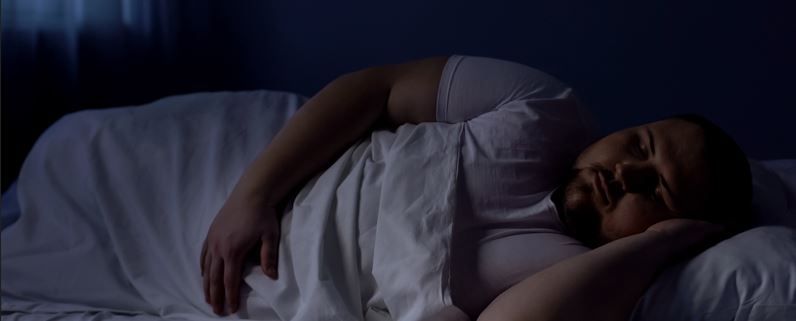- Clinical Technology
- Adult Immunization
- Hepatology
- Pediatric Immunization
- Screening
- Psychiatry
- Allergy
- Women's Health
- Cardiology
- Pediatrics
- Dermatology
- Endocrinology
- Pain Management
- Gastroenterology
- Infectious Disease
- Obesity Medicine
- Rheumatology
- Nephrology
- Neurology
- Pulmonology
Tirzepatide Significantly Reduces OSA Symptoms in Phase 3 Trials, Lilly Looks Toward Mid-2024 Regulatory Submission
Tirzepatide reduced OSA symptoms and body weight in study participants with severe OSA and obesity, regardless of use of positive airway pressure therapy.
©motortion/stock.adobe.com

In individuals with moderate to severe obstructive sleep apnea (OSA) and obesity tirzepatide (Zepbound) reduced OSA severity by nearly two-thirds (63%) regardless of use of positive airway pressure (PAP) therapy, according to an announcement today from tirzepatide developer Eli Lilly.1 The topline findings, from the phase 3 SURMOUNT-OSA clinical trial program, provide the foundation for the company to submit applications for review to the US Food and Drug Administration and other regulators by midyear, Lilly said.1
In the 2 SURMOUNT-OSA program studies (study 1 enrolling individuals on PAP and study 2 comprised of individuals not on PAP), tirzepatide injection, both 10 mg and 15 mg doses, significantly reduced apnea-hypopnea index (AHI) compared with placebo, the trials’ primary endpoint. Tirzepatide also led to significant improvement in key secondary endpoints in both studies, including mean percentage reduction in AHI and mean reduction in body weight from baseline to study week 52, according to the news release.1
Approximately 20 million of the 80 million US adults with OSA live with moderate-to-severe disease and yet 85% of individuals with OSA remain undiagnosed, thus untreated.2 “Addressing this unmet need head-on is critical, and while there are pharmaceutical treatments for the excessive sleepiness associated with OSA, tirzepatide has the potential to be the first pharmaceutical treatment for the underlying disease,” Jeff Emmick, MD, PhD, senior vice president, product development at Eli Lilly said in the company statement.1
Tirzepatide, a first-in-class dual glucose-dependent insulinotropic polypeptide/glucagon-like peptide-1 (GIP/GLP-1) receptor mimetic, was first approved in the US in May 2022 as an adjunct to diet and exercise to reduce hyperglycemia in individuals with type 2 diabetes (T2D) and is marketed as Mounjaro.3 Shortly after, tirzepatide was granted fast-track designation for chronic weight management in adults with obesity or with overweight and at least 1 weight-related condition, receiving FDA approval, as Zepbound, in November 2023.4
SURMOUNT-OSA was a multicenter, randomized, double-blind, parallel, placebo-master protocol designed to compare efficacy and safety of tirzepatide vs placebo in adults living with moderate-to-severe OSA and obesity who were unable or unwilling to use PAP therapy (study 1) and those from the same population who planned to use PAP therapy for the duration of the trial (study 2). Participants were required to have a history of at least 1 self-reported unsuccessful dietary effort to lose body weight.5
The final cohort was drawn from the US and 8 other countries across 5 continents, according to the news release. Using the master protocol, researchers randomly assigned 469 participants in a 1:1 ratio to receive either a maximum tolerated dose (MTD) of tirzepatide 10 or 15 mg or placebo, once weekly by subcutaneous injection. According to Lilly, tirzepatide was initiated at 2.5 mg in both trials with the dose increased by 2.5 mg every 4 weeks until the MTD of 10 or 15-mg was reached.
For the 2 studies, the primary and secondary outcomes of interest were the same: change in AHI from baseline to week 52 and percent change in AHI from baseline and percent change in body weight from baseline to week 52, respectively.
FINDINGS
SURMOUNT-OSA study 1: The researchers’ analysis found that use of tirzepatide in individuals not on PAP therapy was associated with a mean AHI reduction of 27.4 events per hour from baseline to 52 weeks compared to a mean AHI reduction of 4.8 events per hour with placebo therapy in the efficacy estimand. In secondary outcomes, use of tirzepatide was associated with greater reductions in mean AHI (55.0% vs 5.0%) and mean body weight (18.1% vs 1.3%) than placebo therapy from baseline to 52 weeks.1
SURMOUNT-OSA study 2. In this study with individuals on PAP therapy throughout the 52-week study, use of tirzepatide was associated with a mean AHI reduction of 30.4 events per hour from baseline to 52 weeks compared to a mean AHI reduction of 6.0 events per hour with placebo therapy in the efficacy estimand. For the secondary outcomes, the analysis indicated that reductions in mean AHI were greater with tirzepatide therapy (62.8%) vs placebo (6.4%) as were reductions in body weight at 20.3% and 2.3%, respectively, from study baseline to 52 weeks.1
After 1 year of treatment with tirzepatide, weight loss across the 2 SURMOUNT-OSA trials was approximately 20%, a notable decrease in a study population comprised of 70% men who have been shown to lose less weight with incretin mimetic therapy than women, Lilly stated.
The result of the safety analysis from these studies was a profile similar to that seen in the SURMOUNT and SURPASS phase 3 trials of tirzepatide, according to the release.
Lilly plans to present full data from SURMOUNT-OSA at the American Diabetes Association's 84th Scientific Sessions, June 21-24, 2024.
References:
Tirzepatide reduced sleep apnea severity by up to nearly two-thirds in adults with obstructive sleep apnea (OSA) and obesity. News release. Eli Lilly and Company. April 17, 2024. Accessed April 17, 2024. https://investor.lilly.com/news-releases/news-release-details/tirzepatide-reduced-sleep-apnea-severity-nearly-two-thirds.
2 Benjafield AV, Ayas NT, Eastwood PR, et al. Estimation of the global prevalence and burden of obstructive sleep apnoea: a literature-based analysis. Lancet Respir Med. 2019;7(8):687-698. doi:10.1016/S2213-2600(19)30198-5
3 Halsey G. First-in-class tirzepatide wins FDA approval for treatment of type 2 diabetes. Patient Care. May 16, 2022. Accessed April 17, 2024. https://www.patientcareonline.com/view/first-in-class-tirzepatide-wins-fda-approval-for-treatment-of-type-2-diabetes
4 Halsey G. Tirzepatide approved by FDA for chronic weight management in adults. Patient Care. November 9, 2023. Accessed April 17, 2024. 4 https://www.patientcareonline.com/view/tirzepatide-approved-by-fda-for-chronic-weight-management-in-adults
